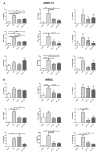Anti-Inflammatory and Anti-Oxidative Synergistic Effect of Vitamin D and Nutritional Complex on Retinal Pigment Epithelial and Endothelial Cell Lines against Age-Related Macular Degeneration
- PMID: 33922669
- PMCID: PMC8170899
- DOI: 10.3390/nu13051423
Anti-Inflammatory and Anti-Oxidative Synergistic Effect of Vitamin D and Nutritional Complex on Retinal Pigment Epithelial and Endothelial Cell Lines against Age-Related Macular Degeneration
Abstract
Age-related macular degeneration (AMD) is a multifactorial disease of the retina featured by dysfunction of retinal pigmented epithelial (RPE) and loss of photoreceptor cells under oxidative stress and inflammatory conditions. Vitamin D and antioxidants have beneficial effects against retinal degenerative diseases, such as AMD. We investigated the impact of associating vitamin D (ND) with a nutritional antioxidant complex (Nutrof Total®; N) on oxidative stress and inflammation-like induced conditions by H2O2 and LPS, respectively, in human retinal epithelial (ARPE-19) and human retinal endothelial (HREC) cells. Application of either N or ND treatments to H2O2-induced media in ARPE-19 cells counteracted late apoptosis, attenuated oxidative DNA damage, and increased cell proliferation. Significant reduction in the expression levels of MCP1, IL-8, and IL6 cytokines was observed following application of either N or ND treatments under LPS-induced conditions in ARPE-19 cells and in MCP-1 and IL12p70 cytokine levels in HREC cells. ND and not N revealed significant downregulation of IFNγ in ARPE-19 cells, and of IL-6 and IL-18 in HREC cells. In conclusion, adding vitamin D to Nutrof Total® protects in a synergistic way against oxidative and inflammatory stress-induced conditions in retinal epithelial and endothelial cells.
Keywords: AMD; inflammation; nutritional complex; oxidative stress; retina; vitamin D.
Conflict of interest statement
A.G.-L. is consultant for Bayer, Novartis, Allergan, Thea, and Roche. The rest of the authors declare no conflict of interest. The funders had no role in the design of the study; in the collection, analyses, or interpretation of data; in the writing of the manuscript; or in the decision to publish the results.
Figures




Similar articles
-
Esculetin Protects Human Retinal Pigment Epithelial Cells from Lipopolysaccharide-induced Inflammation and Cell Death.Curr Eye Res. 2018 Sep;43(9):1169-1176. doi: 10.1080/02713683.2018.1481517. Epub 2018 Jun 6. Curr Eye Res. 2018. PMID: 29806490
-
Vitamin D alleviation of oxidative stress in human retinal pigment epithelial cells.Int Ophthalmol. 2024 Jul 4;44(1):314. doi: 10.1007/s10792-024-03240-4. Int Ophthalmol. 2024. PMID: 38965086
-
Cytoprotective Potential of Fucoxanthin in Oxidative Stress-Induced Age-Related Macular Degeneration and Retinal Pigment Epithelial Cell Senescence In Vivo and In Vitro.Mar Drugs. 2021 Feb 18;19(2):114. doi: 10.3390/md19020114. Mar Drugs. 2021. PMID: 33670685 Free PMC article.
-
Cigarette smoking, oxidative stress, the anti-oxidant response through Nrf2 signaling, and Age-related Macular Degeneration.Vision Res. 2010 Mar 31;50(7):652-64. doi: 10.1016/j.visres.2009.08.018. Epub 2009 Aug 22. Vision Res. 2010. PMID: 19703486 Free PMC article. Review.
-
Dietary Polyphenols in Age-Related Macular Degeneration: Protection against Oxidative Stress and Beyond.Oxid Med Cell Longev. 2019 Mar 24;2019:9682318. doi: 10.1155/2019/9682318. eCollection 2019. Oxid Med Cell Longev. 2019. PMID: 31019656 Free PMC article. Review.
Cited by
-
Vitamin D and Sulforaphane Decrease Inflammatory Oxidative Stress and Restore the Markers of Epithelial Integrity in an In Vitro Model of Age-Related Macular Degeneration.Int J Mol Sci. 2024 Jun 10;25(12):6404. doi: 10.3390/ijms25126404. Int J Mol Sci. 2024. PMID: 38928111 Free PMC article.
-
The effects of vitamin D on cardiovascular damage induced by lipopolysaccharides in rats.J Cardiovasc Thorac Res. 2023;15(2):106-115. doi: 10.34172/jcvtr.2023.31719. Epub 2023 Jun 29. J Cardiovasc Thorac Res. 2023. PMID: 37654818 Free PMC article.
-
Pro-Inflammatory diet accounts for higher prevalence of retinopathy in diabetes participants rather than normal glucose and prediabetes: Results from NHANES, 2005-2008.Front Nutr. 2023 Jan 11;9:981302. doi: 10.3389/fnut.2022.981302. eCollection 2022. Front Nutr. 2023. PMID: 36712506 Free PMC article.
-
Ocular haemodynamics in children with vitamin D deficiency.Eye (Lond). 2025 Apr;39(5):938-942. doi: 10.1038/s41433-024-03528-w. Epub 2024 Dec 2. Eye (Lond). 2025. PMID: 39623114
-
Mitochondrial Dysfunction and Endoplasmic Reticulum Stress in Age Related Macular Degeneration, Role in Pathophysiology, and Possible New Therapeutic Strategies.Antioxidants (Basel). 2021 Jul 23;10(8):1170. doi: 10.3390/antiox10081170. Antioxidants (Basel). 2021. PMID: 34439418 Free PMC article. Review.
References
MeSH terms
Substances
LinkOut - more resources
Full Text Sources
Other Literature Sources
Medical
Miscellaneous

